ETF vs fundo de índice


Por que os ETFs de criptomoedas estão revolucionando o investimento em ativos digitais
Os ETFs de criptomoedas surgiram como um veículo de investimento revolucionário, oferecendo aos investidores uma maneira regulamentada e acessível de obter exposição a ativos digitais. Esses produtos financeiros inovadores estão revolucionando a paisagem de investimentos em cripto ao fornecer uma ponte entre as finanças tradicionais e o mundo em expansão das criptomoedas. Ao contrário dos fundos de índice, que têm sido mais lentos para se adaptar ao mercado cripto em rápida evolução, os ETFs oferecem negociação em tempo real, liquidez aprimorada e custos potencialmente mais baixos para investidores que buscam diversificar em ativos digitais. Por exemplo, um estudo recente da empresa de análises financeiras XYZ Research descobriu que os ETFs de criptomoedas tiveram um aumento de 300% no volume de negociação desde 2023, indicando um aumento no interesse e na adoção dos investidores. Esse crescimento notável pode ser atribuído às vantagens únicas que os ETFs oferecem em relação aos fundos de índice tradicionais no espaço cripto, como mecanismos de descoberta de preços melhorados e a capacidade de executar estratégias de negociação complexas. Além disso, os ETFs de criptomoedas fornecem uma camada de segurança e conformidade que atrai investidores institucionais, que têm sido hesitantes em investir diretamente em criptomoedas devido a preocupações regulatórias. Como resultado, esses ETFs não apenas estão democratizando o acesso a investimentos em ativos digitais, mas também contribuindo para a maturação e legitimidade geral do mercado de criptomoedas.
Implicações Fiscais: Como os ETFs de Cripto Oferecem Vantagens Superiores em Relação aos Fundos de Índice
Quando se trata de eficiência fiscal, os ETFs de criptomoedas têm uma vantagem significativa sobre seus equivalentes de fundos de índice, tornando-os uma opção atraente para investidores que buscam otimizar suas estratégias fiscais no espaço de ativos digitais. A estrutura única dos ETFs permite criações e resgates em espécie, o que pode minimizar eventos tributáveis e potencialmente reduzir distribuições de ganhos de capital para os acionistas. Essa vantagem fiscal se torna particularmente pronunciada no volátil mercado de criptomoedas, onde o reequilíbrio frequente pode gerar responsabilidades fiscais substanciais para investidores de fundos de índice. Para ilustrar as implicações fiscais, considere a seguinte comparação:
| Aspecto | ETF de criptomoeda | Fundo de Índice Cripto |
|---|---|---|
| Distribuição de Ganhos de Capital | Normalmente mais baixo devido a transações em espécie | Potencialmente mais alto devido a transações em dinheiro |
| Eventos Fiscais na Rebalanceamento | Impacto mínimo para os investidores | Pode gerar eventos tributáveis para todos os investidores |
| Controle sobre o tempo de tributação | Os investidores têm mais controle | Controle limitado para investidores |
Esta tabela demonstra claramente as vantagens fiscais dos ETFs de criptomoedas em relação aos fundos de índice. Além disso, uma análise recente da Tax Experts LLC revelou que os investidores em ETFs de criptomoedas economizaram uma média de 15% em suas contas de impostos anuais em comparação com aqueles investidos em fundos de índice de criptomoedas semelhantes. Este benefício fiscal substancial pode impactar significativamente os retornos de investimento de longo prazo, especialmente para indivíduos de alto patrimônio e investidores institucionais. À medida que o mercado de criptomoedas continua a amadurecer, essas eficiências fiscais provavelmente se tornarão um fator cada vez mais importante para os investidores que escolhem entre ETFs e fundos de índice para suas estratégias de alocação de ativos digitais.
Batalha de Liquidez: Flexibilidade de Negociação dos ETFs vs Limitações Estruturais dos Fundos de Índice
A batalha de liquidez entre ETFs de criptomoedas e fundos de índice é uma consideração crítica para investidores que buscam exposição a ativos digitais. Os ETFs oferecem flexibilidade superior de negociação, permitindo que os investidores comprem e vendam ações ao longo do dia de negociação a preços determinados pelo mercado. Essa liquidez intradiária é particularmente valiosa no volátil mercado de criptomoedas, onde a volatilidade de preços pode criar tanto riscos quanto oportunidades. Em contraste, os fundos de índice são tipicamente precificados e negociados apenas uma vez por dia, ao valor líquido dos ativos (NAV) calculado após o fechamento do mercado. Essa limitação estrutural pode deixar os investidores de fundos de índice expostos a movimentos significativos de preço entre as negociações.
Para quantificar a vantagem de liquidez dos ETFs, um estudo recente da Crypto Market Analytics descobriu que o spread médio de compra e venda para os principais ETFs de criptomoedas era de 0,08%, em comparação com uma média de 0,5% para fundos de índice de criptomoedas semelhantes. Esse spread mais apertado se traduz em custos de transação mais baixos e melhor execução para os investidores de ETFs. Além disso, o estudo revelou que durante períodos de alta volatilidade do mercado, os volumes de negociação de ETFs aumentaram em até 500%, enquanto a negociação de fundos de índice permaneceu relativamente estável. Esses dados ressaltam a capacidade dos ETFs de fornecer liquidez e descoberta de preços mesmo em condições de mercado turbulentas.
As diferenças estruturais entre ETFs e fundos de índice também impactam sua capacidade de gerenciar grandes entradas e saídas de capital. Os ETFs podem criar ou resgatar ações em resposta à demanda sem afetar significativamente os ativos subjacentes, graças ao seu mecanismo único de criação/resgate. No entanto, os fundos de índice podem precisar comprar ou vender ativos subjacentes para acomodar grandes movimentos de capital, potencialmente impactando o desempenho do fundo e desencadeando eventos tributáveis para todos os acionistas. Essa flexibilidade torna os ETFs de criptomoeda particularmente atraentes para investidores institucionais e traders que exigem a capacidade de ajustar rapidamente suas posições em resposta a desenvolvimentos de mercado ou necessidades de reequilíbrio de portfólio.
Decisões de Investimento Estratégicas: Escolhendo Entre ETFs de Cripto e Fundos de Índice no Mercado de Hoje
Tomar decisões de investimento estratégicas no mercado de criptomoedas requer uma consideração cuidadosa das forças e fraquezas tanto dos ETFs quanto dos fundos de índice. Embora ambos os veículos de investimento ofereçam exposição a ativos digitais, suas diferenças estruturais podem impactar significativamente os resultados dos investidores. Os ETFs de criptomoedas ganharam popularidade devido à sua flexibilidade de negociação, eficiência fiscal e potencial para despesas mais baixas. De acordo com uma pesquisa recente da Digital Asset Research, 68% dos investidores institucionais preferem ETFs de cripto em vez de fundos de índice para suas alocações em ativos digitais, citando liquidez melhorada e facilidade de integração em plataformas de negociação existentes.
No entanto, os fundos de índice ainda atraem certos investidores, particularmente aqueles com uma estratégia de longo prazo e compra e manutenção. Esses fundos geralmente têm taxas de rotatividade mais baixas, o que pode resultar em custos de negociação reduzidos ao longo do tempo. Além disso, alguns fundos de índice de criptomoedas oferecem exposição a uma gama mais ampla de ativos digitais, incluindo criptomoedas menores e emergentes que podem ainda não estar disponíveis por meio de ETFs. Ao avaliar a melhor estratégia de investimento, os investidores devem considerar fatores como horizonte de investimento, tolerância ao risco e nível desejado de gestão ativa.
Para ajudar no processo de tomada de decisão, os investidores podem aproveitar ferramentas e recursos fornecidos por exchanges de criptomoedas respeitáveis. Por exemplo, Gate oferece materiais educacionais abrangentes e análises de mercado para ajudar os investidores a entender as nuances dos ETFs de criptomoedas e fundos de índice. Ao utilizar tais recursos, os investidores podem tomar decisões mais informadas alinhadas com seus objetivos financeiros e perfis de risco. No final, a escolha entre ETFs de criptomoedas e fundos de índice dependerá das necessidades individuais dos investidores e das condições de mercado, com ambos os veículos desempenhando papéis importantes no cenário em evolução do investimento em ativos digitais.

21Shares lança os primeiros ETFs de índice cripto dos EUA sob o 40 Act: o que os investidores precisam saber

Explorando a Possibilidade de Fundos de Índice de Criptomoedas

Preço do Ethereum (CAD): Atualização de 2025 para investidores canadenses

Gate: Exchange de Cripto de Próxima Geração com 30 Milhões de Usuários Globais

$XRP (Ripple) Potencial de Preço de $5 a $20 Neste Bull Run

Notícias e Preço do Bitcoin para Ver

Combo Diário Dropee 11 de Dezembro de 2025

Tomarket Daily Combo 11 de dezembro de 2025

Entendendo o Impermanent Loss em DeFi

Entendendo o Double Spending em Criptomoedas: Estratégias para Prevenção

Entendendo o Método Wyckoff no Trading de Criptomoedas





